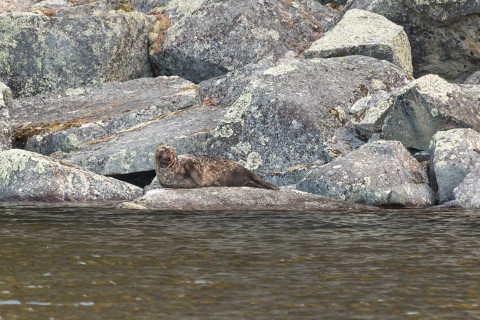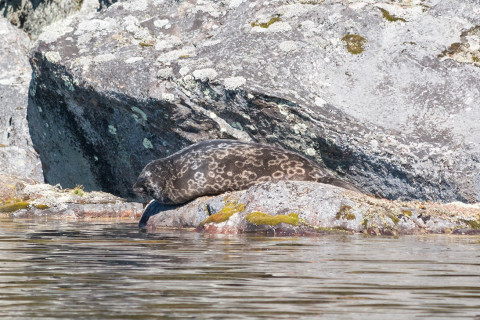A Saimaa ringed seal was successfully translocated from Pihlajavesi basin to Kolovesi basin late this May. This and last year’s translocations seek to maintain the genetic diversity of the Saimaa ringed seal population, and to introduce new individuals to breeding areas that are declining.
This spring’s translocation campaign has been successfully completed. The seal, an adult female known as Jelena, was translocated from Pihlajavesi basin to Kolovesi basin in late May, i.e., during the moulting season when Saimaa ringed seals can be spotted resting on rocks.
“The seal’s capture and transportation by boat went smoothly, just like last year. A veterinarian from Korkeasaari Zoo was there to look after the seal’s well-being, and Jelena was very calm about getting translocated,” says WWF Regional Manager Ismo Marttinen, who works as Fieldwork Manager for the seal translocations.
After translocation, the seal moved in an area covering about five kilometres from its release point. Jelena was still in the process of moulting, and the small satellite tracking device attached to her fur fell off almost immediately.
“This means that we won’t be getting GPS data from this individual, but roughly a week after her release, Jelena was already photographed in her new habitat,” says Researcher Marja Niemi of the University of Eastern Finland.
“So far, we have translocated a total of three Saimaa ringed seals. Amalia, an adult female translocated to Kolovesi basin last year, has already been photographed in her new habitat where she settled last autumn. And we are currently looking for Tuukka, a young adult male translocated to the southern part of Lake Saimaa. Hopefully we’ll be able to find him in our photographs this autumn, as we’ll start identifying seals from this summer’s data,” Niemi says.
The aim of the translocations is to maintain the genetic diversity of the Saimaa ringed seal population and to prevent segregation into sub-populations. Studies show that the genetic diversity of the Saimaa ringed seal population of some 480 individuals is very low and, alarmingly, the population is becoming segregated into sub-populations especially on the southern part of Lake Saimaa and on Kolovesi, where a significant reduction in the number of female seals giving birth is also a cause of concern.
“Thanks to Jelena, our translocation campaign was successful. We hope that Jelena will add to the number of seals giving birth on Kolovesi,” says Miina Auttila Senior Specialist in Nature Conservation at Metsähallitus, Parks & Wildlife Finland.
Seals can be identified by their individual fur patterns, which means that the translocated individuals can be monitored. Thanks to fur pattern identification and DNA sampling, seals can be monitored throughout their life cycle, and DNA samples enable monitoring to continue to future generations, too.
The Saimaa ringed seals were translocated as part of the Our Saimaa Seal LIFE project. The University of Eastern Finland was in charge of the translocations, with Metsähallitus Parks & Wildlife Finland, WWF Finland, Korkeasaari Zoo and the University of Helsinki also contributing.
For further information, please contact:
Marja Niemi, Researcher, University of Eastern Finland (translocation coordination, satellite monitoring of seals, and identification of individual seals): +358 50 341 3654, [email protected]
Miina Auttila, Senior Specialist in Nature Conservation, Metsähallitus Parks & Wildlife Finland (Saimaa ringed seal population monitoring and conservation, regional information on Lake Kolovesi): +358 40 637 6324
Ismo Marttinen, Regional Manager, WWF Finland (seal capture and transport, regional information on the southern part of Lake Saimaa): +358 50 434 9591, [email protected]
Our Saimaa Seal LIFE project website





